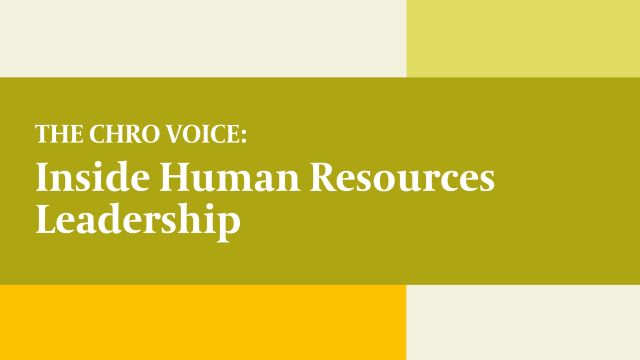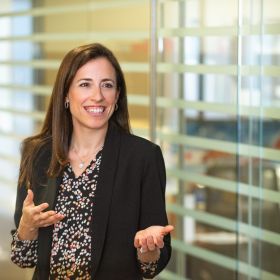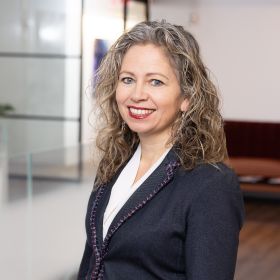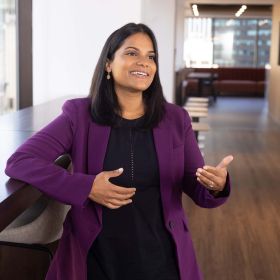We recently developed and deployed our first ever five-year HR strategic plan, well received by the senior leadership team; and that’s because we developed it with them, not for them.
 Deena Baker-NelSenior Vice President and Chief Human Resources Officer of Avery Dennison
Deena Baker-NelSenior Vice President and Chief Human Resources Officer of Avery Dennison
At Avery Dennison, the focus on people and culture is driving significant transformation within the organization. We recently spoke with Deena Baker-Nel, Senior Vice President and Chief Human Resources Officer, to gain insights into how she is preparing the next generation of HR leaders.
Deena discussed the evolving skill set required for HR professionals, the company's approach to hybrid and remote work, and the strategic importance of diversity and inclusion. She also highlighted exciting initiatives such as the implementation of a new internal talent marketplace and advancements in HR technology, all aimed at enhancing employee experience and organizational efficiency and effectiveness.
As you bring up the next generation of HR leaders at Avery Dennison, how do you see the skill set for HR leaders evolving?
Top of mind, I’d say a more significant focus on strategic leadership, business acumen, change leadership and coaching. Other HR-specific capabilities critical to delivering business goals are those in talent management, organizational effectiveness and people operations. Business acumen can come from rotations in all areas of the business - whether in HR or elsewhere; and change leadership is critical at Avery Dennison. Change is constant as we focus on value creation for all of our stakeholders.
Capability in digital, AI, and technology are now table stakes. Enabling technology to enhance the employee experience while helping our business leaders solve problems more effectively and efficiently is exciting and value added work. This contributes to business effectiveness, efficiency and productivity. Today’s leaders want real-time data at their fingertips, so skills in this area are essential for the future.
Finally, I’d say HR leaders who are focused on stakeholder alignment will go far. We always serve multiple stakeholders and those we are successful in facilitating win-win outcomes will do well.
How do you prioritize and implement HR strategies in response to the evolving needs of the business?
We recently developed and deployed our first ever five-year HR strategic plan, well received by the senior leadership team; and that’s because we developed it with them, not for them. This ensures their input throughout and alignment with the final outcome (back to the stakeholder alignment reference I made earlier). This was a very fulfilling process, because the team worked with the leaders and each other while leveraging critical internal and external insights to develop the plan. Our strategy is directly connected to the needs of the business, and we know it's a living document, with continuous prioritization, based on business-critical changes. This also validates our seat at the table as business leaders, focusing on what is right for all of our stakeholders: employees, customers, shareholders, communities.
How is Avery Dennison navigating hybrid and remote work models?
When we first started remote work during COVID, our strong relationships across many long-tenured employees helped us navigate those early days. Just like so many other companies, we relied on these bonds and our culture to problem-solve and check in on each other. However, we knew we would eventually need to be back in person to nurture those relationships. With regular turnover and new employees joining around the globe, it's challenging to maintain the same level of connection, though we recognize that some people will always prefer remote work.
As a general rule, much of our employee base is “back to office” around the world 2-3 days per week; and of course our colleagues in manufacturing and in labs have remained onsite. We can never go back to 2019; we don't work that way anymore. We need to think about what is different when we get back to the office and what will make people want to be there, leading with intentionality both from the leader and the employee perspective. One question we’d anticipate employees would ask is ‘how can I add or get value by going into a local office when my company network is global?’ When and if we formalize a minimum “return to office” guideline, we want to ensure we're doing all we can to promote and reward innovation, collaboration and teamwork.
Capability in digital, AI, and technology are now table stakes. Enabling technology to enhance the employee experience while helping our business leaders solve problems more effectively and efficiently is exciting and value added work.
Deena Baker-NelSenior Vice President and Chief Human Resources Officer of Avery Dennison
What are the important considerations as you make that shift?
There are a number of considerations should we decide to formalize anything down the road: logistics, commute times, schedules, flexibility, office culture, meetings with half of the team on screen and half together in one meeting room. We’d need to find and model new ways of collaborating, innovating and networking. The goal would be for this to feel and be additive, not punitive.
Have you noticed any benefits or challenges related to the shift toward a more flexible office presence?
We've been working like this for five years now across the company, and even longer for a large part of our organization. One of our businesses is truly global, with decisions in one part of the world truly driving outcomes in another. They have always exercised meaningful flexibility given travel schedules and early morning and late night calls.
Flexibility is still very important regardless of our office guideline. We do believe we benefit when we have more time in person with colleagues, adding value, learning, teaching, collaborating, and providing thought partnership. It's not about losing flexibility or productivity. It’s about building on it. Our goal is to strike the right balance and foster our culture.
How has building diverse, inclusive workforces evolved at Avery Dennison, and how are you thinking about it now?
For a long time, we focused on gender diversity. As we progressed in that journey, we felt it was necessary to go further, and we wanted to be thoughtful about our approach and implement sustainable changes that we could maintain and truly embed in our culture. We focused first and continue to focus on inclusion because it shapes our culture, improves engagement, and makes room for people with diverse backgrounds and perspectives. We have strategic pillars through our inclusion strategy that emphasize fairness and transparency. For example, it's important that all employees have access to and knowledge of available opportunities. Another example is that we have a consistent and fair approach when hiring, developing and promoting employees.
Last year, we deployed an enterprise-wide competency model, which has been a great contributor to our HR strategy overall and contributes directly to our fairness pillar as part of our DEI work. The model clarifies a standard for what we expect of ourselves and each other. This model helps managers have the right conversations with employees, offering real examples of strengths and areas for improvement. It also provides transparency and greater clarity of expectations.
We also have many employee resource groups globally, open to everyone. These are founded and led by our employees, they are not employer driven.
Last year, we deployed an enterprise-wide competency model, which has been a great contributor to our HR strategy overall and contributes directly to our fairness pillar as part of our DEI work. The model clarifies a standard for what we expect of ourselves and each other.
Deena Baker-NelSenior Vice President and Chief Human Resources Officer of Avery Dennison
In response to the recent executive orders:
- We feel confident that our overall strategy and the work we've done aligns well with the spirit of the orders. Our focus has always been grounded on merit, inclusion, fairness and transparency. All decisions we make are centered around fostering our culture with the best talent in and from all communities.
- By driving inclusion first and foremost, our goal is to have access to the best talent from all communities.
Clearly, you've done a lot of thinking and work in this area. It's amazing. What are you most proud of?
With over 36,000 employees around the globe who naturally show up with diverse perspectives, I'm most proud of all we've done and continue to do to foster an open, transparent, and trusting culture. This helps to ensure all Avery Dennison employees come to a safe workplace, allowing them to focus on delivering value for all of our stakeholders. This ensures we have access to the best people everywhere. It's not easy, and we don’t get everything right the first time.
We are here to do the right thing for the business, our stakeholders, our teams, and our culture.
Anything you're particularly excited about that you're working on?
We're in the middle of a human capital management software implementation, which I'm very excited about. This isn't my area of expertise, but my team is amazing here. Just one example of what the team is developing in this area is an internal talent marketplace. Our employees will have the flexibility to engage, build their profiles, see more transparently what opportunities exist and make their interests known. This ties back to my points about fairness and transparency. Individuals can choose to create a profile (or not), and they can see short-term assignments, projects, and gigs. This will require change management, and we have a lot to figure out, but I'm excited about how technology can help us and our teams maximize opportunities to deliver for the business while contributing to their own development.
We also continue to innovate in HR operational areas, advancing efficiency, productivity, and simplicity while striking the right balance between standardization and customization. We’re in the middle of an HR service delivery model change to accelerate progress here. This is a key area that gives us credibility to innovate elsewhere when it comes to our people, which is why we’re so invested in it.
What advice would you give to the 22-year-old Deena starting your career in this field?
- Take roles out of your comfort zone
- Seek roles (within HR or elsewhere across the business) where the learning curve is steep
- Accept various assignments you know nothing about across multiple centers of excellence
- Surround yourself with those who have strengths you do not so you can win together and so you can learn from each other
- Live and work overseas, embrace the cultural challenges and live like a local
- Be humble, ask for help, and roll up your sleeves.











